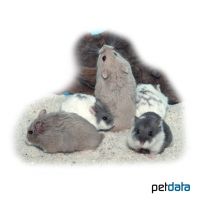Campbell's Hamster-Mixed (Phodopus campbelli)
| Campbell's Hamster-Mixed Phodopus campbelli | |
|---|---|
| Name | Campbell's Hamster-Mixed |
| Name Lat. | Phodopus campbelli |
| Family | Cricetid Rodents |
| Family lat. | Cricetidae |
| Order | Rodents |
| Order lat. | Rodentia |
| Origin | East Asia (breeding variety) |
| Climate | Temperate |
| Habitat | Steppe |
| Diet | Dwarf hamster food, herbs, hay, insects |
| Behavior | Nocturnal; semi-aggressive |
| Keeping | Individual, pair |
| Care Level | Moderate |
| Life Span | 2-3 years |
| Protection | No |
| Metric Units | |
| Size | 9-11 cm |
| Temperature | Room temperature |
| Housing | 80 x 30 x 40 cm |
| US Units | |
| Size | 3.5"-4.3" |
| Temperature | Room temperature |
| Housing | 30" x 12" x 15" |
Distribution and habitat
The predominantly nocturnal Campbell's dwarf hamsters live in barren steppe and desert areas of northeast China, Manchuria and Mongolia. They inhabit self-dug burrows, where they also store their food supplies. They are bred in numerous color varieties.
Maintenance
Minimum dimensions for the enclosure:
| 1-2 animals | area: 0.3 m² | height: 40 cm |
| Each additional animal | Area: + 20 |
A terrarium or rodentarium of 100 x 50 x 50 cm (L x W x H) is recommended, placed in a bright (no direct sunlight), draught-free and quiet place, with ventilation openings at the sides, and it must not be tightly closed at the top.
The enclosure should be variedly structured with stones, roots and branches, and with floors placed at different heights, and should provide hiding and sheltering places (rodent houses, tubes, clay caves, etc.). They need food and drinking containers (drinking bottles), a sand bath (chinchilla sand) for grooming, nesting material (hay, etc.) and a substrate for digging. Commercially available small animal litter or a peat-soil mixture (unfertilized potting soil) is suitable as substrate. The bedding depth should be 15 cm, but better 20 cm. Nail material, such as untreated twigs and branches of fruit trees, as well as a rodent stone, must always be available to wear down their teeth. They should be kept at room temperature and their natural day-night rhythm should be respected.
Diet
They feed mainly vegetarian, but also need animal protein. The diet consists of a low-fat grain mixture, available in specialized shops as "dwarf hamster food", supplemented with feed hay, dried herbs, green fodder (dandelion), root vegetables, occasionally live insects (meal beetle larvae, grasshoppers, crickets, etc.) and especially during pregnancy and rearing of young animal protein (insect and egg food). Fruit must be offered only rarely and in very small quantities (risk of diabetes). Drinking water must always be available in hanging bottles or in stable, open containers and, like food, must be offered fresh daily
A varied diet promotes health and prevents deficiency symptoms.
Behaviour and compatibility
They are rather loners. The individual compatibility in pair keeping, however, also depends on the rearing, the housing conditions as well as the furnishing and size of the cage with sufficient sleeping hiding places. At the first signs of incompatibility, the animals should be separated immediately.
Reproduction and breeding
Testes can be clearly seen in sexually mature males, and the distance between the anus and the urethral opening is greater in juvenile males than in females.
The gestation period is between 18 and 22 days. The young are born naked, blind and deaf. They nurse until the 21st day, after which the young may be separated from the mother. They are sexually mature after about 45 days.
Important
The activity maximum is shortly after sunset and shortly before sunrise
On the abdomen is the so-called ventral gland (scent gland), which is particularly pronounced in the male and secretes a yellowish secretion to mark the territory.
Their cheek pouches are expandable skin sacs, which are also used for impersonation and threatening. Special attention should be paid to the length of the permanently regrowing teeth. Teeth that are too long hinder food intake
Allow the animals controlled exercise outside the cage several times a week. Further literature can be found in your pet store
References
Text: petdata; Image: petdata
Source: W. PUSCHMANN, D. ZSCHEILE, K. ZSCHEILE (2009): Zootierhaltung - Tiere in menschlicher Obhut: Säugetiere, Harri Deutsch Verlag; BMEL (2014): Gutachten über Mindestanforderungen an die Haltung von Säugetieren
- Gemäß § 21 Abs. 5 Tierschutzgesetz idgF
